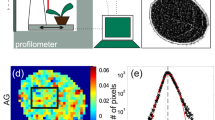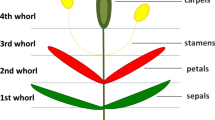Abstract:
The veins of plant leaves exhibit a large variety of morphologies. They are often thought to result from their growth in a concentration scalar field. It is shown here that the topology of these patterns rather corresponds to what is expected from growth in a tensorial stress field. This is demonstrated by analogic experiments performed on crack formation in gel films where many characteristic venation patterns, of both dicotyledons and monocotyledons, were reproduced. This suggests, for the origin of the veins formation, a set of hypotheses which is new but supported by known physiological data.
Similar content being viewed by others
Author information
Authors and Affiliations
Additional information
Received 11 March 2002 Published online 19 July 2002
Rights and permissions
About this article
Cite this article
Couder, Y., Pauchard, L., Allain, C. et al. The leaf venation as formed in a tensorial field. Eur. Phys. J. B 28, 135–138 (2002). https://doi.org/10.1140/epjb/e2002-00211-1
Issue Date:
DOI: https://doi.org/10.1140/epjb/e2002-00211-1




